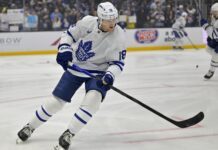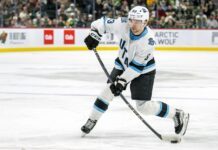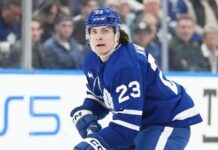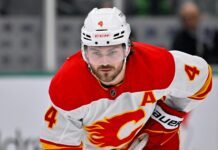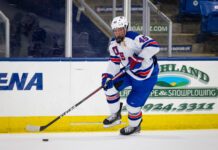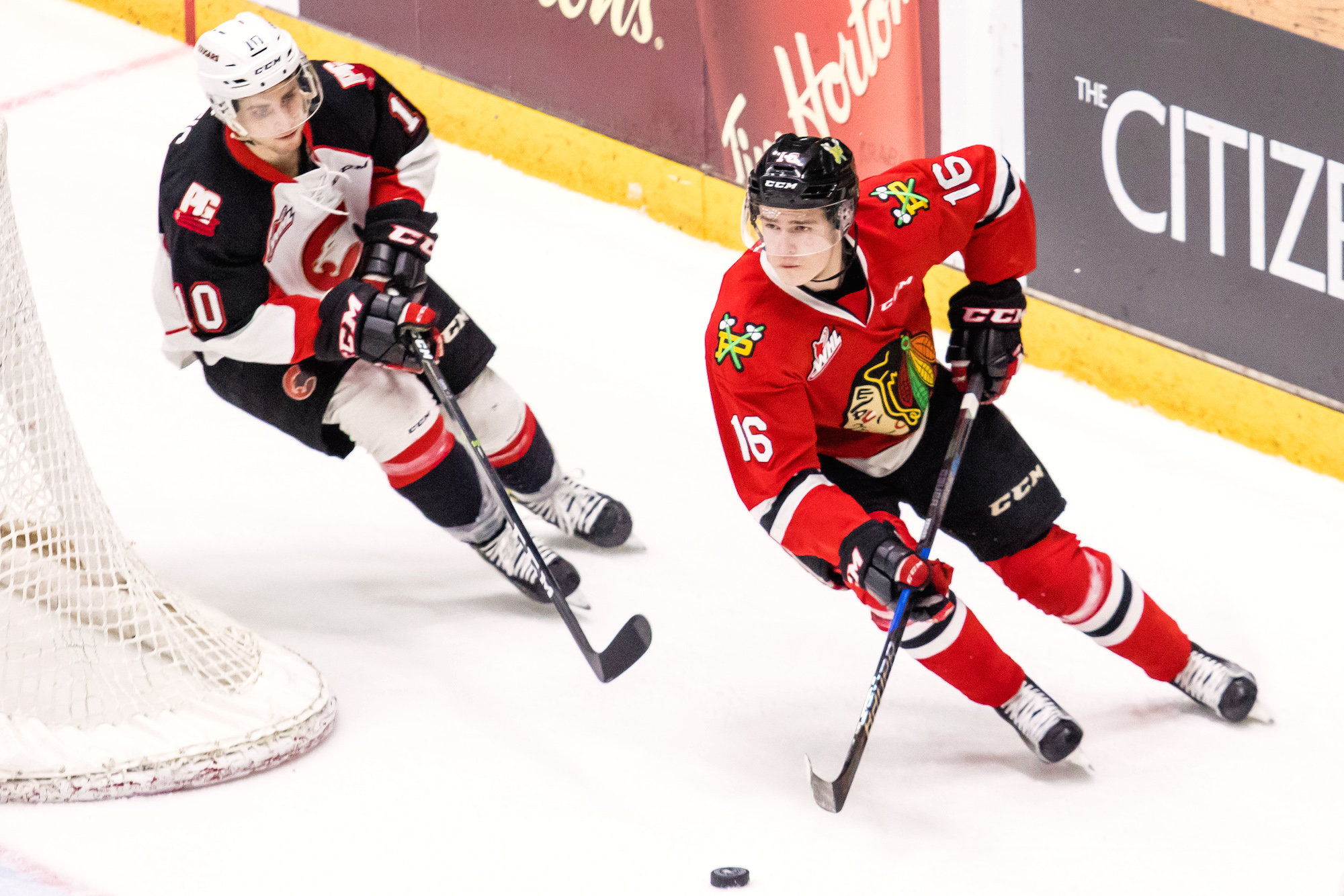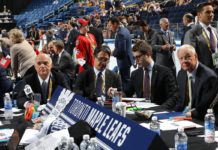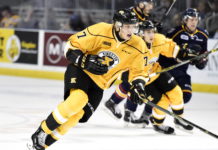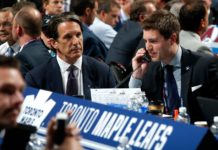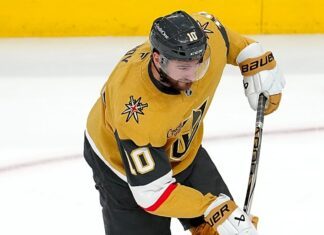One of four Finnish defencemen who could be selected inside the first round of the 2017 NHL Draft, Henri Jokiharju possesses many of the qualities associated with the “modern defenceman” archetype.
What the 17-year-old Oulu native lacks in size he makes up for with intelligence, skating and puck-moving ability, all of which helped Jokiharju adjust to the North American game in his first year with the Portland Winterhawks in 2016-17.
Like Tri City’s Juuso Valimaki, Jokiharju crossed over from the Jr. A SM-liiga to play junior hockey in the Western Hockey League, but he did so a year later, making his draft season his rookie year in the CHL. While Valimaki enjoyed one of the most productive draft years by a CHL defenceman since 2015, Jokiharju was productive in his own right. His 48 points in 71 games placed him 17th in WHL defence scoring and first among rookies; he ranked fourth in points among the WHL’s first-year draft eligible defencemen and second in even strength points with 26 (one ahead of Kelowna’s Cal Foote). With a June birthdate, Jokiharju is also nine months Valimaki’s junior.
In addition to their clashes in the WHL, the two squared off on opposite sides of the CHL/NHL Top Prospects Game in January, where Jokiharju made headlines with a three-assist performance for Team Cherry — a prospects-game record for points by a defenceman that helped Jokiharju generate some buzz as a potential first round draft selection. In his post-game analysis, Sportsnet’s Sam Consentino likened Jokiharju’s game to Derick Pouliot, a former Winterhawks defenceman who went eighth overall to Pittsburgh in the 2012 draft.
Jokiharju was also starting to gain momentum in his WHL season as the year wore on. After 10 points in his first 23 games in the first two months of the season, he tallied 38 in his final 48. With 19-year-old defenceman Caleb Jones — a fourth round draft choice of the Oilers in 2015 — off at the World Junior Championships competing for Team USA, Jokiharju responded well to an increase in responsibility, tallying six points in six games during Jones’ absence.
The right-shot rearguard is undersized by traditional NHL standards, although — similar to his production — he showed visible signs of growth in that area as the season progressed, sprouting up an inch over the course of the 2016-17 season (he’s now around the 6’0 mark) and beefing up to 188 pounds as of last week’s draft combine.
Whether Jokiharju goes on the first day of the draft remains to be seen. He was ranked 29th by ISS Hockey, 31st by McKeen’s, 19th among North American skaters by NHL Central Scouting, and 34th by Craig Button in his final list. NHL.com’s Adam Kimmelman projected him going as high as 17th — to the Toronto Maple Leafs — in his recent mock draft.
Henri Jokiharju Scouting Reports
HockeyProspect.com’s Andy Levangie:
I liked his Top Prospects game, but when you cruised through some of the articles on that game, it seemed like people really, really loved what he did in that game. I thought he had a good game, but I don’t know if he was quite as amazing as people said. But I did appreciate it and he did fill the stat sheet with three assists.
He’s got good feet, and he’s got good hand-eye coordination, which is something I appreciate from him. I appreciate his stick. I’ve seen him knock down a few loose pucks and pick things out of the air with a really good hand-eye coordination. He uses his stick a lot, from what I can understand. He’s reaching with that stick and poking away with stick, and not always engaging with the body and tying guys up as much as he should, so I think there is a tendency to stay a foot or two further away than he should.
He’s confident carrying the puck. I liked him on zone exits, for sure. I don’t think he’s got a tonne of power play points, which is always something I look for. If a guy racks it up on the power play, maybe it’s a bit of a question mark, but if he can do that 5-on-5, there is a bit more to translate there.
He does lean on guys around the net a little bit. He’s got good positioning around the net. I do like his first pass and his passes around the offensive zone. Not a good booming shot, or anything like that, but he keeps the fluidity of the offense going.
Jokiharju started off a little slow as he adjusted to hockey life in North America, but he made the transition and was very good in Portland as a WHL rookie. I’ve always been impressed by his skill set and think he has significant NHL upside. He’s a great skater and one of the more mobile defenders available in this class. He’s a smart, two-way defenseman who can dictate tempo and move the puck efficiently. I don’t think his skill is top-end level, but he’s going to be able to rack up a lot of points thanks to his vision, feet and decision-making. Despite not being a big guy, Jokiharju is quite effective defensively because he’s very smart with his positional play.
I spoke with Portland Winterhawks head coach Mike Johnston about the specifics of Henri Jokiharju’s game and his development over the course of his rookie season.
Interview: Mike Johnston on Henri Jokiharju
You guys selected Henri late in the first round of the 2016 import draft, coming off a nice season in Finland that included an appearance as a 16-year-old in the U18 tournament for the gold-medal winning Finns. What did the scouts like about him and what was the expectation level for him coming into the year?
Johnston: I wasn’t at the U18 in person, but I watched a lot of the video when I took the job in May of last year. We had two guys down there that watched. At the U18 that year, Finland had a really good team. Henri was an underage guy at the tournament; so really, for him, I wouldn’t say he was a standout player there, but if you really watched his game, you could see he was intelligent. He moved really well on the ice. He had a lot of good attributes about him. We had heard that he might want to come to North America, so we started talking to his agents and seeing what the possibility was. We decided that we needed a defenceman and he was going to be the guy if he was available.
Obviously, he proved you guys right by having a good rookie season. How quickly did he get acclimated over here in terms of the rink size, playing style, and off-ice lifestyle? It seemed like he turned a bit of a corner in late November, finishing his regular season with 38 points in 48 games after 10 in his first 23 games.
Johnston: It’s a big adjustment. When you move away from home, that’s number one. As a young kid, you’re homesick a little bit; that type of thing. That was a big adjustment along with the smaller ice surface, as you mentioned. Defencemen, in our game, are under a lot more pressure than they are in Europe. That was something that I saw earlier in the year – the forechecking pressure from other teams was a little bit tougher for him to handle, more so physically than being able to read it and make good decisions. But he got used to that as time went along.
I thought the big turning point for him was when Caleb Jones was away for a month at the World Juniors. He became one of our top guys and he was on our top power play and really took off at that time.
He’s listed at 170 pounds on a number of the profiles online, but he measured in at 188 pounds at the combine. Has he thrown on quite a bit of good weight just in the year you’ve been with him?
Johnston: Yeah, he has. He’s not a guy who is going to put on any extra weight. He grew about just over an inch during the season last year. He still hadn’t finished growing. I think he’s right around six feet now and 185-plus. Certainly, he did put on strength throughout the course of the year. We do a lot of weight training and pretty well do training every day. I thought you could see a big difference in him by January or February. I’ve heard he’s had good training in the last six or seven weeks since he’s been home, too.
I think the way that the game is going… if you look at Nashville, they don’t have many defencemen over six feet. If you really look at the way the game is going with NHL teams, everybody is looking for a good, mobile, smart, strong defenceman. Size isn’t one of the top things anymore. It’s intelligence, and Henri is really smart. He reads the play really well and he is great on his edges. He’s a good skater that can escape traffic and he’s got really good deception. He’s a smart puck mover. I believe he has more offensive skills than we saw this year even. There were a lot of times where I thought he could’ve jumped up into the play a little bit more and used his shot a little bit more from the point.
48 points as a rookie is a solid return, knowing that. Some of the scouting reports suggest he could stand to add some power to his slapshot, but that he’s effective when it comes to getting wrist shots through to the net. Would that be a fair assessment?
Johnston: Yeah, it is. I think at the prospect game he did that and that’s how he got three assists in that game; by just making sure he got his wrist shot through to the net. His slapshot is improving. It’s something I know he’s working on to get better because I think you need versatility from there. You need to be able to walk the line and heat it up sometimes, and you need to be able to finesse it and get it through other times. That’s something that he can add to his game.
It’s definitely ideal to have both in your toolbox. You would have an interesting perspective on this, having recently coached in the NHL: Is the prototypical howitzer from the point less emphasized in the modern game now that there is so much focus on getting into shot lanes defensively, with wingers leaned on more defensively? They’re not just asked to block shots — they’re expected to, and it seems like a premium is placed on finding shooting lanes and getting pucks through.
Johnston: Yeah, I do agree with that. If you look at Brent Burns, one of his biggest strengths is that he just gets his shot through. He finds a way to get a lane. Sometimes those lanes get taken away if you walk the line and really try to take a big slapshot because players can get down in front of it. It takes a few extra seconds. I also feel there is a time and value with a guy who can shoot the puck hard, who has a bomb from the point that everybody is intimidated by if he does get it through.
He looks like a good puck mover whose head is always up. How are his reads in terms of when to take it and rush himself versus hitting a forward in stride on the breakout? As he gained confidence, did he rush it more as the year went on?
Johnston: Yeah, he did. It’s more of our style of play, too. I think he was just getting used to how we like to play. We play a fairly aggressive style with our defence with the puck. We’re always jumping with the puck. It was him getting used to the style and getting comfortable. Again, I think we just saw a piece of what he can do. I think he can do a lot more in that area.
Getting a better sense of his defensive game… in terms of things like his gap control, ability to escape danger and transition the puck out of his own end, his skating is a big plus to his game. Really smooth on his edges and a really fluid backwards skater.
Johnston: Yep, that’s his strength, for sure.
At his size, how is he in those one-on-one battles in the corners and at the net front?
Johnston: He’s just okay. He’s average right now, but I think getting used to it in North America and getting used to the battles and getting stronger physically himself is really going to help him. He’s got a really good stick defensively, so he doesn’t often have to engage in a lot of those battles. If you look at Hjalmarsson or guys like that, they don’t engage in a lot of big physical battles. They try to get the puck off of you with a good stick and transition the puck.
Did you lean on him in the toughest matchups throughout the year?
Johnston: For sure. He was in our top-four all year, so he’s matched against other team’s top players. When Caleb was away, he was always against the top guys. He has no problem playing against top players. Earlier in the year, I thought he lost some strength battles, but he did get better as he was playing against bigger, stronger guys as the year went along.
Just the three assists in 11 games in the playoffs. How did you think he adjusted to playoff hockey?
Johnston: It’s different for them because a lot of the kids in Europe don’t play seven-game series. They play a tournament format, which is much, much different. We had probably the hardest travel in the entire Canadian Hockey League having to go back and forth to Prince George over the first series. Everything was different for a kid coming over like that.
I thought he played really well in the playoffs. Two or three of our 11 games were subpar, but other than that, he really contributed and played well. We asked him, as a 17-year-old player – the same as Cody Glass, too – to play big minutes, play top roles, and play against the best players on the other teams, who were usually older. It was a tough task, but I thought he really played well.

